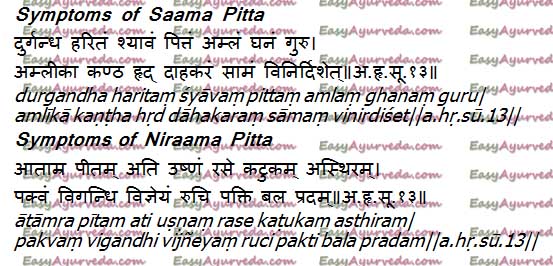Pitta Associated With Ama – Symptoms And Treatment
Article by Dr Raghuram Y.S. MD (Ay) & Dr Manasa, B.A.M.S
Pitta dosha can be aggravated in association with ama. This condition is called Sama Pitta. When Pitta is not associated with ama, it is called Nirama Pitta.
Table of Contents
Saama and Nirama Pitta
Symptoms of Saama and Niraama Pitta
Pitta alone can cause diseases when it gets vitiated. Such diseases we call as prakupita pitta janya vyadhis or pittaja diseases. This condition is totally different from saama pitta i.e. pitta associated with toxins derived from improper digestion of food.

Symptoms of Saama Pitta
Durgandham – foul smelling due to association with ama
Haritam – pitta gains greenish color
Shyavam – appearance of blackish or bluish black color in pitta
Amlam – pitta acquires sour taste
Ghanam – pitta becomes denser and stable i.e. when placed over the surface of water saama pitta doesn’t float on it
Guru – heaviness develops in pitta in contrast to its light nature
Amlika – manifestation of sour belching
Kantha daha karam – causes burning sensation in the throat
Hrid daha karam – causes burning sensation in the cardiac region
Symptoms of Nirama Pitta
Tamra – pitta acquires coppery color
Peeta – pitta acquires yellow color
Ati ushnam – manifestation of excessive heat
Katuka rasa – pitta acquires bitter taste
Asthiram – pitta is unstable i.e. breaks into fragments and scatters on water
Vigandhi – absence of foul smell in pitta
Ruchi pradam – enhances taste in food
Pakti pradam – enhances digestion capacity of an individual by kindling the digestive fire
Bala pradam – increases strength and immunity of an individual
Saama Pitta treatment
Treatment principles of Saama Pitta
The principle of treating pitta associated with ama lay in separating the vicious combination of ama and pitta. Though therapeutic Virechana (purgation) is the chief treatment for morbid pitta, purgation should not be directly administered in this condition. If therapeutic purgation is administered it cannot expel the pitta from the body because the pitta associated with the endo-toxins have adhered to the walls of the cells, tissues and channels of the body owing to the sticky nature of ama.
The purgation therapy administered will try to pull this adhered pitta from the tissues and channels and in doing so will damage those structures and components of the body. This will eventually lead to many complications and may even cause death of the patient.
Pachana – Therefore initially ama digestive medicines should be administered in this pathological condition. These medicines owing to their pungent and bitter tastes, hot quality and potency, hot after-digestion effect, would digest ama and eventually separate it from the pitta association. At the same time these medicines would detach the ama from the walls of tissues and channels and prepare them to be expelled.
Agni deepana – medicines which kindle the digestive fire should also be administered to rectify the digestion process and metabolism. With this the digestive fire will gain strength and will digest the food properly, in such a way that ama would not be formed in future.
Snehana, Swedana and Shodhana – after separation of ama, internal consumption of medicated ghee are administered followed by sudation therapy. This will liquefy and mobilize the pitta towards the stomach. From here, the pitta should be eliminated by administering medicated purgation.
Importance
Need for knowing Saam and Niram Pitta conditions
It is very essential for a physician to know about the saam and niraam conditions of pitta because in spite of both being morbid stages will differ in terms of their pathological presentation and treatment when compared to the vitiated pitta. The knowledge will help the physician to differentiate saama pitta from vitiated pitta and hence make appropriate treatment choices.
Click to Consult Dr Raghuram Y.S. MD (Ayu) – Email / Skype







5 comments
Suvasinii Rai
What is the treatment for Irritable bowel syndrome?
Jaideep
I’m a bit confused. What’s the difference between sama pitta condition and kapha-pitta condition?
Ama and kapha have very similar properties thus I’m confused.
Dr J V Hebbar MD(Ayu)Author
Ama and Kapha are slightly different. Ama has stickiness and Kapha has unctuousness.
Jaideep
In sama pitta the sanskrit verse says “amlam – the pitta acquires sour taste”.
So can we say amla-pitta is basically a sama pitta condition and not a nirama pitta condition?
Or in other words sama pitta is a synonym of amlapitta?
Dr J V Hebbar MD(Ayu)Author
Though the symptoms are similar, I believe, there is some difference.
Saama Pitta is a unique condition with ama with Pitta, with sourness as just one of the many symptoms.
Amlapitta is a specific digestive disorder with sourness + Vidagdhata of Pitta.